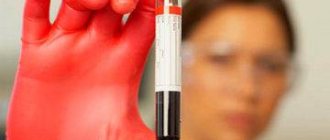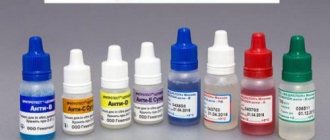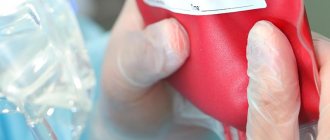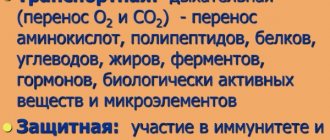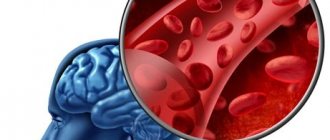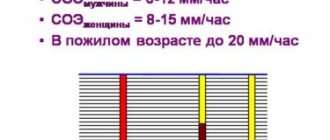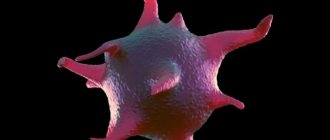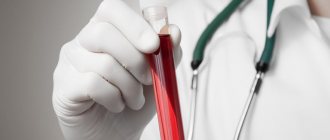Rh factor
During scientific research in 1940, an antigen was found in the blood of macaques, which later received the name Rh factor. It is hereditary and depends on race. Those people who have this antigen in their blood are Rh positive, and if it is absent, they are Rh negative.
Transfusion compatibility:
- Rh negative is suitable for transfusion to people with Rh negative;
- Rh positive is compatible with any Rh blood.
If you use Rh-positive blood for a patient with a Rh-negative category, then special anti-Rhesus agglutinins will be produced in his blood, and with another manipulation, red blood cells will stick together. Accordingly, such a transfusion cannot be carried out.
Any transfusion is stressful for the human body. Whole blood is transfused only if the loss of this biological fluid reaches 25% or higher. If less volume is lost, blood substitutes are used. In other cases, transfusion of certain components, for example, only red blood cells, is indicated, depending on the type of lesion.
Health risks
But this is not all the interesting and important facts. The compatibility of blood groups 1 and 2 (positive) is now clear. Moreover, it is now clear what character traits the carriers of this informational genetic unit are endowed with. An extremely important point is the health status of a person with A+.
Some believe that blood type has a serious impact on the human body. In addition to character traits, people acquire certain vulnerabilities. For example, such citizens have the following characteristics:
- low immunity that occurs due to infections, stress, poor diet or physical activity;
- increased blood clotting;
- tendency to thrombosis;
- impaired absorption of proteins and fats;
- low stomach acidity.
Accordingly, 2 positive blood group, the compatibility of which we already know, gives a person the following vulnerabilities:
- diseases of the cardiovascular system;
- allergic reactions;
- increased susceptibility to foodborne infections;
- predisposition to gastritis, pancreatitis;
- risks of developing malignant tumors.
Perhaps these are all the health features that need to be remembered. What else important can you learn about people with positive blood group 2?
How to determine blood type
To determine the blood group during transfusion, standard serum is taken and the blood being tested is dripped into it. This serum contains certain antibodies. The blood reaction occurs with antigens in the red blood cells. They are either similar to antibodies in serum or they are not. Red blood cells in different blood groups agglutinate with a certain serum, that is, they accumulate into a small mass.
- Example: to detect the third (B) and fourth blood group (AB), serum containing anti-B antibodies is used.
- For the second (A) and fourth (AB), serum containing anti-A antibodies is prepared.
- Blood group 1 (0) does not cause any reactions with any serum.
Blood group test
Prevention of the problem
The most reliable method of prevention is for a woman to choose an equally Rh-negative partner as her mate. Then the occurrence of Rh conflict is completely excluded. If this is not possible, the following measures should be taken.
- Prevent the development of anti-Rhesus antibodies: when transfusing Rh+ blood to a woman;
- during abortion;
- during the first pregnancy.
For this purpose, anti-Rhesus immunoglobulin is used. It destroys Rh+ fetal red blood cells in a woman’s body, preventing the response production of antibodies to them. The injection is carried out intramuscularly. The main condition is to administer the drug 24-72 hours after the infusion of Rh+ blood, before the onset of the immune response. It is often administered before labor begins.
- Before each pregnancy, undergo a mandatory medical examination for the presence of the first symptoms of a developing conflict: ultrasound;
- Dopplerometry;
- cardiotocography;
- amniocentesis;
- cordocentesis;
- blood test for the presence of antibodies.
Blood compatibility
The most important criterion for choosing a donor for a patient is group compatibility of blood during transfusion. To answer the question why there is no blood compatibility, you need to know that there is no universal group for everyone, but a special table will help you choose the right one, which shows the blood groups that are suitable for everyone:
Blood compatibility chart
- For example, a person of the first group is an ideal blood donor; it is suitable for all other groups; the fourth is a universal recipient.
- The first group (0) can be transferred to all other groups without any problems, but it can only receive its own, the first.
- The second (A) is suitable for the second and fourth, but can accept its own and the first.
- The third (B) is a donor for its own and the fourth group and accepts only the third and first.
- The fourth blood group (AB) is an ideal recipient; it accepts all blood groups, but only the fourth is suitable as a donor.
In addition to human blood groups, there is another important criterion by which the donor and recipient are matched to each other. Great importance is attached to the Rh factor or antigen. It can be positive and negative, they are incompatible.
For example, if blood is transfused from a blood donor with a third blood group and a negative Rh factor to a patient with the same group with a different Rh factor, the patient’s native plasma sticks to the donor’s red blood cells, causing an incompatibility reaction. In medicine, this process is called an agglutination reaction and leads to death. The number of antigens in blood plasma is also determined by different systems.
Interesting Facts
As already mentioned, there are 2 types of blood - positive or negative. The most common option is the first. 2 positive blood group, the characteristics of which will be presented below, is present in a larger number of the population around the world.
It is noted that this type of blood appeared only after the 1st. Some suggest that this is related to the development of humanity. Primitive people were able to eat carbohydrates. They began to engage in gathering and farming. During this, the 2nd blood group was formed.
If you briefly describe people with this “substance”, you will notice that they are sociable and flexible. In addition, they tend to idealize the world. People with blood type 2 are excellent organizers.
Blood compatibility for conceiving a child
Before pregnancy, planning a child needs to be approached wisely. Reproduction specialists advise parents to determine blood compatibility in advance. The child’s inheritance of a certain set of qualities from each partner will depend on this, and checking Rh compatibility will help protect against hemolysis during pregnancy. If a woman is Rh-, and a man is Rh-positive, a Rh-conflict arises, in which the body perceives the fetus as foreign and begins to fight, actively producing agglutinins (antibodies) against it.
- What disability group is given for grade 3 knee gonarthrosis?
Rhesus conflict poses a danger not only for the expectant mother. Hemolytic disease can occur when positive and negative red blood cells react in the fetal bloodstream. Ottenberg's rule can determine whether conception will be successful based on blood type:
- it will help protect the couple by finding out what diseases can arise during conception and pregnancy;
- establish an approximate scheme of combination of a set of chromosomes during the formation of a heterozygote;
- guess what Rh factor the child may have;
- determine height, eye and hair color.
Compatibility table of blood groups and Rh factor
The ratio of the blood type of the father and mother determines the possible inheritance of qualities and genes by the child. Incompatibility does not mean the inability to get pregnant, but only indicates that problems may arise. Knowing in advance is better than finding out when it's too late. It is better to check with your doctor which blood groups are incompatible for conceiving a child. Compatibility table of blood groups and Rh factor:
| Blood type | 0(I)Rh+ | 0(I)Rh- | A(II)Rh+ | A(II)Rh- | B(III)Rh+ | B(III)Rh- | AB(IV)Rh+ | AB(IV)Rh- |
| 0(I)Rh+ | + | — | + | — | + | — | + | — |
| 0(I)Rh- | — | + | — | + | — | + | — | + |
| A(II)Rh+ | + | — | + | — | + | — | + | — |
| A(II)Rh- | — | + | — | + | — | + | — | + |
| B(III)Rh+ | + | — | + | — | + | — | + | — |
| B(III)Rh- | — | + | — | + | — | + | — | + |
| AB(IV)Rh+ | + | — | + | — | + | — | + | — |
| AB(IV)Rh- | — | + | — | + | — | + | — | + |
The probability of a child inheriting the Rh factor:
| Dad | Mother | Baby |
| Positive | Positive | 75% positive 25% negative |
| Positive | Negative | 50/50 |
| Negative | Positive | 50/50 |
| Negative | Negative | Completely negative |
Treatment of incompatibility
If there is a Rh conflict after birth, the newborn is transfused with blood with the maternal group and the Rh group. This avoids exposure to the mother's antibodies that have entered the baby's body. Upon contact with familiar blood, the antibodies are neutralized.
Prevention with immunoglobulins is also carried out after abortions, miscarriages, prolonged labor, and ectopic pregnancy. Today, Rh conflict can be controlled with medications. Parents with incompatibility have every chance of bearing a healthy child.
Blood group compatibility
In the 20th century, the idea of transfusion arose. Blood transfusion is a useful procedure that restores the total volume of blood cells; plasma proteins and red blood cells are replaced. The compatibility of the blood groups of the donor and recipient during transfusion is important, affecting the success of the blood transfusion. Otherwise, agglutination will occur - a fatal gluing of red blood cells, resulting in the formation of a blood clot, which leads to death. Blood compatibility for transfusion:
| Blood type | Recipients | Which ones can you transfuse from? |
| 0(I) | I, II, III, IV | I |
| A (II) | II, IV | I, II |
| B(III) | III, IV | I, III |
| AB(IV) | IV | I, II, III, IV |
First
The first blood group is considered to be the foundation of human civilization. Our ancestors developed the habits of excellent hunters, brave and persistent. They are ready to spend all their strength to achieve their intended goal. Modern first-bloods need to be able to plan their actions in order to avoid rash actions.
Main character traits:
- natural leadership;
- extroversion;
- better organizational skills.
Strengths:
- strong digestive system;
- physical endurance;
- increased ability to survive.
Weaknesses are considered:
- Types of arthrosis and their degrees for which a disability group is given
- increased acidity (risk of peptic ulcer);
- predisposition to allergies, arthritis;
- poor clotting;
Second
City dwellers. Evolution moved forward and people began to engage in agriculture. When plant protein became the source of human energy, the vegetarian second blood group arose. Fruits and vegetables began to be used as food - the human digestive system began to adapt to changing environmental conditions. People began to understand that following the rules increases their chances of survival.
Main character traits:
- communication skills;
- constancy;
- composure.
Strengths:
- good metabolism;
- excellent adaptation to change.
Weak sides:
- sensitive digestive system;
- weak immune system.
Third
People with the third blood group are called nomads. It is difficult for them to experience an imbalance within themselves, in the team. It is better to live in mountainous areas or near water bodies. They suffer from a lack of motivation because their bodies produce large amounts of cortisol when they are stressed.
Main character traits:
- flexibility in decisions;
- openness to people;
- versatility.
Strengths:
- strong immunity;
- tolerate changes in diet well;
- creative.
Weak sides:
- Is disability allowed for arthrosis of the knee and other joints?
- susceptible to autoimmune diseases;
- lack of motivation and self-confidence.
Fourth
Holders of the rarest, fourth blood group occurred as a result of the symbiosis of the second and third. A bohemian, easy life is what characterizes its representatives. They were tired of everyday decisions and devoted themselves to creativity. The total number of people with such a group is only 6% on the planet.
Main character traits:
- mysterious;
- individual.
Strengths:
- resistant to autoimmune diseases;
- resist allergic manifestations.
Weak sides:
- fanatics, capable of going to extremes;
- Drugs and alcohol should be avoided.
About choosing a profession
Who is the best person to work for carriers of the 2nd positive blood group? To do this, you need to pay attention to the characteristics of a person’s character. Nature has come up with many professions for such people.
All the previously mentioned features should not be overlooked. People with blood type 2 (positive) are excellent teachers, doctors, and social workers. They work wonderfully with personnel and can help in election campaigns. It is in these areas that it is recommended to choose a profession for such citizens.
About nutrition
For example, it is recommended to pay special attention to nutrition. For the category of people under study, it implies a gentle regime. How should nutrition be organized according to blood type? 2 positive (the table of permitted products will be presented below) blood is not only a tendency to leadership, but also an organization for the prevention of obesity.
Accordingly, you need to eat right. It is noted that many people with A+ tend to be vegetarians. Their main diet is vegetables and fruits. Vegetable oils are also beneficial. For example, flaxseed or olive. Cereals allowed for consumption are buckwheat, rice, millet, barley. Don't forget about beans and lentils either. A+ cereals are a great menu item.
Among vegetables and fruits, preference should be given to those that enhance the formation of gastric juice. For example: cherries, oranges, apples, pineapples, beets, carrots, bell peppers, cucumbers. Spices are not recommended. You can leave only the mustard.
Drinks recommended for all carriers of blood type 2+: coffee, tea, sour juice, wine (red).
Seafood and delicacies can be consumed, but in limited quantities. Garlic, ginger, soy sauce and drinks with malt are also not recommended. Despite this, they are not prohibited. Soy substitutes are allowed to be used without restrictions.
